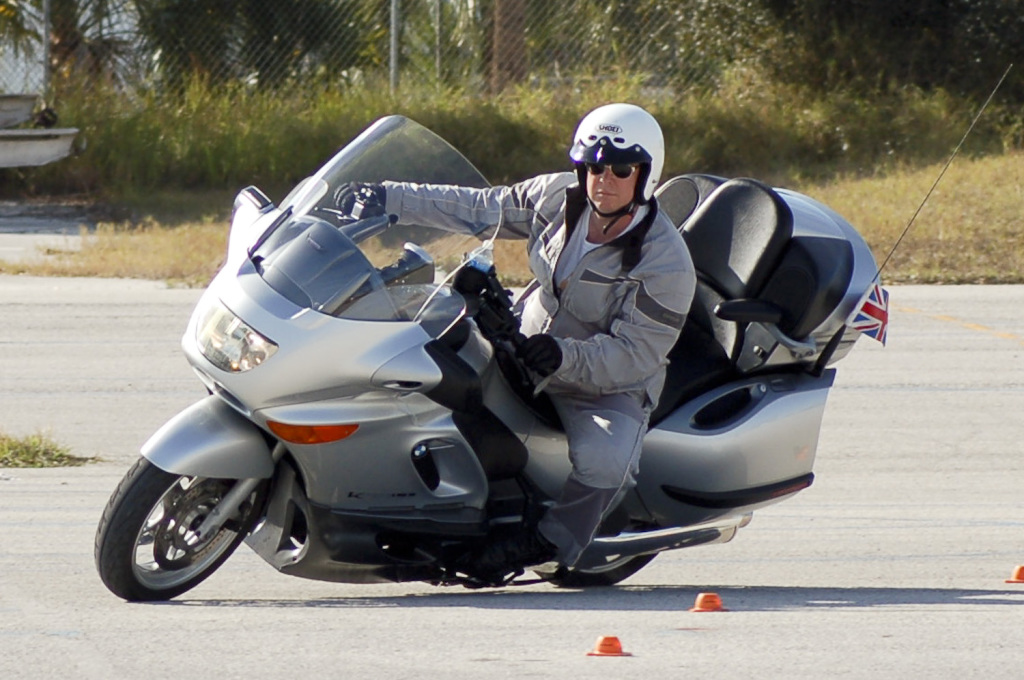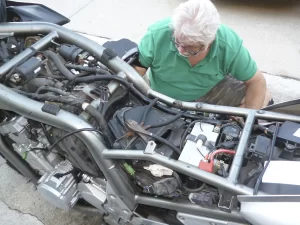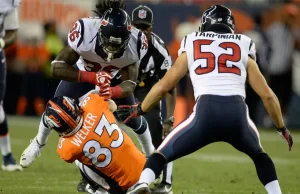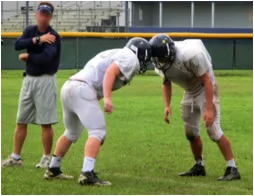Motorcycle Accident Expert
Motorcycle collision analysis is a highly specialized discipline in which Dr. Lloyd is eminently qualified as a motorcycle accident expert. In addition to holding a PhD in Ergonomics (Human Factors), with a specialization in Biomechanics, John has more that 20 years and 200,000 miles of experience riding motorcycles.  Dr. Lloyd has completed numerous advanced programs, including Motorcycle Safety Foundation (MSF), Experienced Rider Course and Total Rider Tech Advanced training.
Dr. Lloyd has completed numerous advanced programs, including Motorcycle Safety Foundation (MSF), Experienced Rider Course and Total Rider Tech Advanced training.
Motorcycle Helmets and Brain Injury
To consider whether a motorcycle helmet might reduce the risk of brain trauma in a motorcycle accident it is first important to understand the two primary mechanisms associated with traumatic brain injury – impact loading and impulse loading.
Impact loading involves a direct blow transmitted primarily through the center of mass of the head, resulting in extracranial focal injuries, such as contusions, lacerations and external hematomas, as well as skull fractures. Shock waves from blunt force trauma may also cause underlying focal brain injuries, such as cerebral contusions, subarachnoid hematomas and intracerebral hemorrhages. Whereas, impulse or inertial loading caused by sudden movement of the brain relative to the skull, produces cerebral concussion. Inertial loading at the surface of the brain can cause subdural hemorrhage due to bridging vein rupture, whereas if affecting the neural structures deeper within the brain can produce diffuse axonal injury (DAI).
Holbourn was the first to cite angular / rotational acceleration as an important mechanism in brain injury. Gennarelli, Thibault, and colleagues, in a series of studies using live primates and physical models investigated the role of rotational acceleration in brain injury. They concluded that angular acceleration contributes more than linear acceleration to brain injuries, including concussion, axonal injury, and subdural hematoma.
Motorcycle Helmet Testing
Traditional testing of motorcycle helmets focuses on reducing the effect of linear impact forces by dropping them from a given height onto an anvil and measuring the resultant peak linear acceleration. According to the Federal Motor Vehicle Safety Standard (FMVSS) 218, commonly known as the DOT helmet standard, the test involves dropping a motorcycle helmet onto a flat steel and hemispherical anvil at an impact velocity of 6.0 m/s (13.4mph). In general, if peak linear acceleration is less than 400g, the helmet is considered acceptable. Current motorcycle helmet testing standards do not incorporate measures of angular acceleration and therefore do not address whether any helmets can provide adequate protection against catastrophic brain injuries, such as concussion, axonal injury and subdural hematoma.
In 1995, the European Commission Directorate General for Energy and Transport initiated a Cooperative Scientific and Technical Research (COST) program to investigate Motorcycle Safety Helmets. Several agencies from Finland, the United Kingdom, France and Germany participated in this study, which compiled and analyzed data from 4,700 motorcycle fatalities in Europe, each year. The COST report documents that 75% of all fatal motorcycle accidents involve head injury. Linear forces were present in only 31% of fatal head injuries, while rotational forces were found to be the primary cause in over 60% of cases. Within the scope of this study experiments were performed using drop tests with accelerometers to measure linear and rotational accelerations of the brain and skull mass associated with different types of impacts. These tests confirmed rotational acceleration to be a primary cause of brain injury in helmeted motorcycle accidents.
- Rotational forces acting on the brain are the underlying cause of traumatic brain injuries.
- Motorcycle helmets, including those certified under DOT and SNELL standards are designed to mitigate forces associated with linear acceleration.
- Motorcycle helmets are not currently certified under either DOT or SNELL standard against their ability to protect against the angular / rotational forces.
- Epidemiologic evidence from the COST-327 report indicates that motorcycle helmets do not provide adequate protection against closed head and brain injuries
Human Factors of Motorcycle Accidents
Human factors in vehicle collisions include all factors related to drivers and other road users that may contribute to a collision. Examples include driver behavior, visual and auditory acuity, decision-making ability, and reaction speed. A 1985 report based on British and American crash data found driver error, intoxication and other human factors contribute wholly or partly to about 93% of crashes.
Motorcycle Inspection
Motorcycle accident analysis often requires involves a teardown and careful inspection of the machine to investigate for possible contributing factors. Our engineers have a combined 70 years experience with motorcycle mechanics.
A thorough evaluation includes inspection of tires, brakes, suspension setup, electrical components as well as any aftermarket parts.



